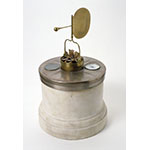Anemometer consisting of a brass wind vane mounted on a cylindrical holder and inserted in a cistern set in a marble base. The mercury, which originally filled the cistern, allows the wind vane to float and move freely. Two pairs of paddle-wheels and a threaded conoid pivot horizontally under the wind vane. On the conoid was originally fixed a thread with a counterweight. The wind turned the conoid, winding the thread in ever-wider coils. At a given point, the force of the wind acting on the paddles exactly counterbalanced the force of the counterweight: the paddles stopped moving and were blocked by a pallet. The maximum velocity reached by the wind could be estimated by observing the counterweight's position. The base carries a metal crown housing a compass and a bubble level, and inscribed with a windrose.









